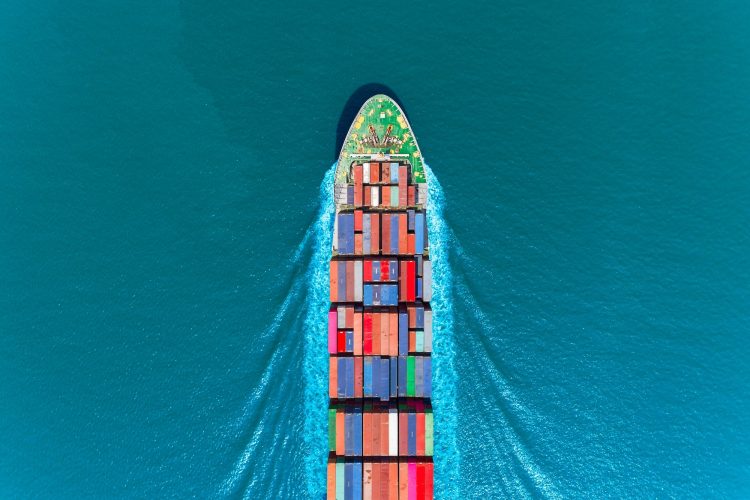TriplePundit • With Global Emissions Rules Held Off, What’s Next for the Shipping Industry?

Last month, the U.S. joined Saudi Arabia and several other nations to force a delay in new emissions rules for cargo ships, citing increased costs. Still, shipping stakeholders continue working on alternative pathways, demonstrating that fossil fuels will inevitably shrink their footprint in the global transportation sector regardless of US energy policy.
New rules for the global shipping industry
The International Maritime Organization’s new Net-zero Framework was initially approved in principle earlier this year. The decision marks the first time that a global fuel standard and pricing platform for greenhouse gas emissions has been added to the existing maritime pollution treaty, called MARPOL.
“The plan outlines a multilayered system built around a fuel benchmark and a dual-level carbon levy — set at $100 and $380 per metric ton of CO2-equivalent emissions,” Vasil Velev, founder of the online publisher Carbon Herald, reported this fall. “It also introduces tradeable tax credits, which shipping companies could roll over and apply against future tax obligations.”
The rules apply to ships larger than 5,000 gross tonnage, a maritime term referring to the amount of space inside a ship rather than its weight. This category accounts for 85 percent of the carbon emissions from the global shipping industry.
The new rules also represent the first time that mandatory emissions standards will be imposed across an entire global industry, setting the stage for similar decarbonization measures in other sectors.
The shipping decarbonization movement is not stopping
Formal adoption of the new standard was set to take place at a meeting of the International Maritime Organization’s Marine Environment Protection Committee in October, and go into effect in 2027. But the Committee adjourned on October 17 without reaching an agreement and pushed the vote to October 2026.
A one-year delay is a significant setback as climate impacts continue to rise. Globally, oceangoing cargo ships already account for 3 percent of total greenhouse gas emissions, more than the aviation industry. According to the United Nations news service, participating nations will keep working toward a 2050 net zero goal until the Committee reconvenes next year. During the delay, for example, a working group is continuing to develop detailed implementation guidelines for the new rules.
The shipping industry also continues to develop new resources to support carbon-cutting technologies. One example is a China-U.K. collaboration to create the International Maritime Future Technologies Innovation Center, a virtual resource center launched last week with the goal of promoting new low- and zero-carbon maritime technologies. Spearheaded by the Chinese firm COSCO Shipping Group, the initiative also features Shanghai Jiao Tong University in China along with the leading U.K. maritime classification society LR (Lloyd’s Register) and the University of Southampton. New technologies developed through the center will be tested and validated on COSCO’s fleet and operational systems.
More decarbonization solutions are rising
New technologies that save both money and fuel are already contributing to progress. Along with green ammonia and other new, lower-carbon liquid fuels, wind energy is beginning to make a comeback at sea. Some firms have already introduced smaller-scale cargo sailing ships to the industry, the French companies Vela and Grain de Sail being two examples.
The movement to revive sailing ships has accelerated after a long period of R&D. The European startup NEOLINE Développement, for example, started the pre-development phase for a large-scale cargo sailing ship back in 2011. The building phase began in 2023, and in October of this year, the consortium launched its inaugural sailing ship, the Neoliner Origin, on a round trip to the U.S. and back to Europe.
Other shipping industry innovators have been developing rigid sails that can be retrofitted on existing ships to help save fuel. Most of these devices do not resemble conventional sails at all, such as the rectangular columns developed by Oceanbird of Sweden and GT Wings (formerly Green Energy Technologies) in the U.K.
The Finnish firm Norsepower is already growing its roster of shipping clients for another type of wind-related device called the Rotor Sail. Norsepower has verified a fuel and emissions savings of 5 to 25 percent with the potential for additional savings when conditions are optimal. The sails can be installed as retrofits and accessories to new ships, too. Last year, the company announced a major expansion of its operations with the opening of a new Rotor Sail factory in China.
Some innovators are also beginning to introduce solar panels. The U.S. startup Voltic Shipping, for example, is developing electric cargo ships that combine solar energy with route optimization and other energy-saving strategies. Other emerging solutions include on-board carbon capture and conversion systems, lightweight shipbuilding materials, and hull treatments that save fuel by reducing friction.
Next steps for net zero shipping
Another factor helping to ratchet down shipping emissions is the acceleration of renewable energy development on land. An estimated 40 percent of all global shipping vessels transport fossil fuels. All else being equal, those ships will no longer be needed — or at least far fewer of them will be — as renewable energy and sustainable fuel production become distributed more evenly around the world.
“Countries like Chile and Namibia who voted in favour of [the International Maritime Organization’s Net-zero Framework] have a lot to gain from an e-fuels future powered by renewable energy and are significantly investing in home-grown e-fuels,” William Todts, executive director of the U.K. organization Transport and Environment, recently observed. Those e-fuels he’s referring to are e-kerosene and other liquid fuels that can be synthesized from locally-produced green hydrogen and captured carbon.
Though a disappointment to nuclear opponents, the idea of a nuclear-powered cargo fleet has also attracted the attention of influential shipping stakeholders including LR, which last month published new guidance for nuclear powered commercial shipping and other offshore industries. “As the maritime sector accelerates its transition toward sustainable energy solutions, nuclear power has re-emerged as a viable solution to achieve net-zero ambitions,” LR noted.
Despite the abrupt shift in federal energy policy this year, the U.S. government may yet play a supporting role in the carbon-cutting effort. South Korea, a strong and active supporter of the International Maritime Organization’s new emissions rules, has reportedly pledged $150 billion to support the U.S. shipbuilding industry as part of a new trade deal. Japan has also pledged collaboration as well.
Featured image: Getty Images/Unsplash



Post Comment